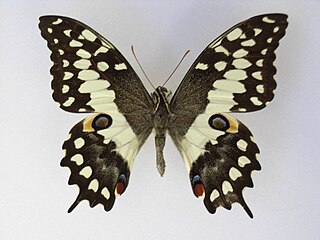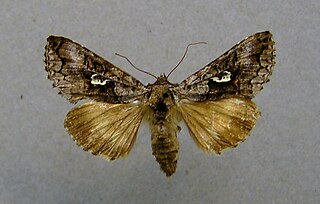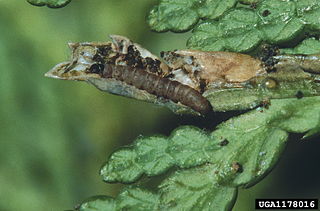
Nacaduba hermus, the pale four-line blue, is a species of lycaenid butterfly found in Indomalayan realm. The species was first described by Baron Cajetan von Felder in 1860.

Papilio morondavana, the Madagascan emperor swallowtail, is a species of butterfly in the family Papilionidae. It is endemic to Madagascar. The habitat consists of forests.

Syngrapha interrogationis, the scarce silver Y, is a moth of the family Noctuidae. It is found in northern part of the world including Alaska, Canada, Iceland, Europe, Siberia, the Pacific Northwest region of the United States, and Northeast Asia.

Coleotechnites thujaella is a moth of the family Gelechiidae. It is found in the north-eastern parts of the United States, as well as Canada.

Coleotechnites milleri is a moth of the family Gelechiidae. It is found in the western parts of the United States, as well as Canada.

Coleotechnites moreonella, the ponderosa pine needleminer, is a moth of the family Gelechiidae. It is found in the United States, where it has been recorded from Colorado.

Cosmopterix orichalcea is a moth of the family Cosmopterigidae. It is known from most of Europe east to Japan.
Helcystogramma gypsaspis is a moth in the family Gelechiidae. It was described by Edward Meyrick in 1921. It is found on Java in Indonesia.
Coleotechnites alnifructella is a moth of the family Gelechiidae. It is found in North America, where it has been recorded from Virginia.
Coleotechnites colubrinae is a moth of the family Gelechiidae. It is found in North America, where it has been recorded from Texas.
Coleotechnites coniferella is a moth of the family Gelechiidae. It is found in North America, where it has been recorded from California, Illinois, Indiana, Maryland, Massachusetts, Michigan, Minnesota, Mississippi, New York, Ontario, Washington and Wisconsin.
Coleotechnites elucidella is a moth of the family Gelechiidae described by William Barnes and August Busck in 1920. It is found in North America, where it has been recorded from California.
Coleotechnites gallicola is a moth of the family Gelechiidae. It is found in North America, where it has been recorded from Colorado and California.
Coleotechnites invictella is a moth of the family Gelechiidae. It is found in North America, where it has been recorded from California.
Coleotechnites juniperella is a moth of the family Gelechiidae. It is found in North America, where it has been recorded from New Jersey.
Coleotechnites petulans is a moth of the family Gelechiidae. It is found in Colombia, Ecuador and Peru.
Coleotechnites pinella is a moth of the family Gelechiidae. It is found in North America, where it has been recorded from Colorado.
Battaristis cyclella is a moth of the family Gelechiidae. It was described by August Busck in 1903. It is found in North America, where it has been recorded from Arizona and Utah.
Nealyda pisoniae is a moth of the family Gelechiidae. It was described by August Busck in 1900. It is found in Cuba and the United States, where it has been recorded from Florida.
Cryptophasa phycidoides is a moth in the family Xyloryctidae. It was described by Thomas Pennington Lucas in 1901. It is found in Australia, where it has been recorded from New South Wales and Queensland.





